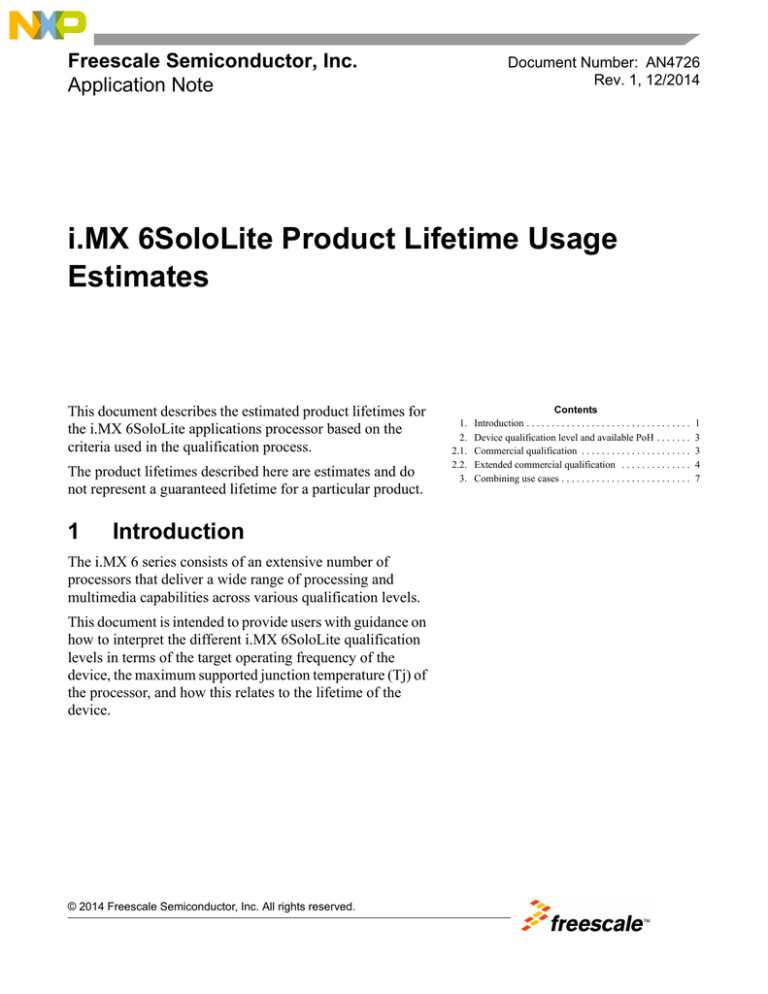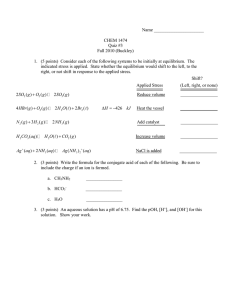
Freescale Semiconductor, Inc.
Application Note
Document Number: AN4726
Rev. 1, 12/2014
i.MX 6SoloLite Product Lifetime Usage
Estimates
This document describes the estimated product lifetimes for
the i.MX 6SoloLite applications processor based on the
criteria used in the qualification process.
The product lifetimes described here are estimates and do
not represent a guaranteed lifetime for a particular product.
1
Introduction
The i.MX 6 series consists of an extensive number of
processors that deliver a wide range of processing and
multimedia capabilities across various qualification levels.
This document is intended to provide users with guidance on
how to interpret the different i.MX 6SoloLite qualification
levels in terms of the target operating frequency of the
device, the maximum supported junction temperature (Tj) of
the processor, and how this relates to the lifetime of the
device.
© 2014 Freescale Semiconductor, Inc. All rights reserved.
1.
2.
2.1.
2.2.
3.
Contents
Introduction . . . . . . . . . . . . . . . . . . . . . . . . . . . . . . . . .
Device qualification level and available PoH . . . . . . .
Commercial qualification . . . . . . . . . . . . . . . . . . . . . .
Extended commercial qualification . . . . . . . . . . . . . .
Combining use cases . . . . . . . . . . . . . . . . . . . . . . . . . .
1
3
3
4
7
Introduction
Each qualification level supported (Commercial and Extended Commercial) defines a number of power-on
hours (PoH) available to the processor under a given set of conditions, such as:
• The target frequency for the application (commercial and extended commercial).
a) The target frequency is determined by the input voltage to the processor’s core complex
(VDD_ARM_IN).
b) The use of LDO-enabled or LDO-bypass mode.
– When using LDO-bypass mode, the target voltage should not be set to the minimum
specified in the datasheet. All power management ICs have allowable tolerances. The target
voltage must be set higher than the minimum specified voltage to account for the tolerance
of the PMIC. The tolerance assumed in the calculations in this document is +/-25mV.
– LDO-enabled mode uses the regulators on the i.MX 6 series. These regulators are well
characterized and can be set to output the exact minimum specified voltage. Longer
power-on-hours can be achieved using LDO-enabled mode.
• The percentage of active use vs. standby.
a) Active use means that the processor is running at an active performance mode.
– For the commercial and extended commercial tiers, there are two available performance
modes: 996 MHz and 792 MHz.
b) In standby/DSM mode the datasheet defines lower operating conditions for VDD_ARM_IN,
VDD_SOC_IN and VDD_PU_IN, reducing power consumption and junction temperature. In
this mode, the voltage and temperature are set low enough so that the effect on the lifetime
calculations is negligible and treated as if the device were powered off.
• The junction temperature (Tj) of the processor.
a) The maximum junction temperature of the device is different for each tier of the product, e.g.
95oC for commercial and 105oC extended commercial. This maximum temperature is
guaranteed by final test.
b) Users must ensure that their device is appropriately thermally managed such that the
maximum junction temperature is not exceeded.
All data provided within this document are estimates for PoH that are based on extensive
qualification experience and testing with the i.MX 6 series. These statistically derived estimates
should not be viewed as a limit on an individual device’s lifetime, nor should they be construed as a
guarantee by Freescale as to the actual lifetime of the device. Sales and warranty terms and
conditions still apply.
i.MX 6SoloLite Product Lifetime Usage Estimates, Application Note, Rev. 1, 12/2014
2
Freescale Semiconductor, Inc.
Device qualification level and available PoH
2
Device qualification level and available PoH
2.1
Commercial qualification
Table 2 provides the number of PoH for the typical use conditions for the commercial device.
Table 1. Commercial qualification lifetime estimates
ARM Core Speed
(MHz)
Power-on Hours
[PoH]
(Hrs)
ARM Core
Operating Voltage
(V)
Junction
Temperature [Tj]
(oC)
Case C1: LDO Enabled
996, 792
21,900
1.25
95
Case C2: LDO Bypassed
996, 792
21,900
1.275
95
Figure 1 and Figure 2 establish guidelines for estimating PoH as a function of CPU frequency and junction
temperature. PoH can be read directly off of the charts below to determine the necessary trade-offs to be
made to CPU frequency and junction temperature to increase the estimated PoH of the device.
65,000
60,000
55,000
Power-on Hours
50,000
45,000
40,000
35,000
30,000
25,000
20,000
15,000
10,000
70
75
80
85
90
95
Junction Temperature (°C)
Commercial 792MHz (1.15V)
Commercial 996MHz (1.25V)
95C - Max Specified Temp
Qualified Mission Profile Use-Case
Figure 1. i.MX 6SoloLite commercial lifetime estimates LDO enabled mode
i.MX 6SoloLite Product Lifetime Usage Estimates, Application Note, Rev. 1, 12/2014
Freescale Semiconductor, Inc.
3
Device qualification level and available PoH
yp
65,000
60,000
55,000
Power-on Hours
50,000
45,000
40,000
35,000
30,000
25,000
20,000
15,000
10,000
70
75
80
85
90
95
Junction Temperature (°C)
Commercial 792MHz (1.18V)
Commercial 996MHz (1.275V)
95C - Max Specified Temp
Qualified Mission Profile Use-Case
Figure 2. i.MX 6SoloLite commercial lifetime estimates LDO bypass mode
2.2
Extended commercial qualification
Table 2 provides the number of PoH for the typical use conditions for the extended commercial device.
Table 2. Extended commercial qualification lifetime estimates
ARM® Core Speed
(MHz)
Power-on Hours
[PoH]
(Hrs)
ARM Core
Operating Voltage
(V)
Junction
Temperature [Tj]
(oC)
Case E1: LDO
Enabled
996, 792
21,900
1.25
105
Case E2: LDO
Bypassed
996, 792
15,430
1.275
105
Figure 3 and Figure 4 establish guidelines for estimating PoH as a function of CPU frequency and junction
temperature. PoH can be read directly off of the charts below to determine the necessary trade-offs to be
made to CPU frequency and junction temperature to increase the estimated PoH of the device.
i.MX 6SoloLite Product Lifetime Usage Estimates, Application Note, Rev. 1, 12/2014
4
Freescale Semiconductor, Inc.
Device qualification level and available PoH
65,000
60,000
55,000
Power-on Hours
50,000
45,000
40,000
35,000
30,000
25,000
20,000
15,000
10,000
70
75
80
85
90
95
100
105
Junction Temperature (°C)
Ext Commercial 792MHz (1.15V)
Ext Commercial 996MHz (1.25V)
105C - Max Specified Temp
Qualified Mission Profile Use-Case
Figure 3. i.MX 6SoloLite extended commercial lifetime estimates LDO enabled mode
i.MX 6SoloLite Product Lifetime Usage Estimates, Application Note, Rev. 1, 12/2014
Freescale Semiconductor, Inc.
5
Device qualification level and available PoH
yp
65,000
60,000
55,000
Power-on Hours
50,000
45,000
40,000
35,000
30,000
25,000
20,000
15,000
10,000
70
75
80
85
90
95
100
105
Junction Temperature (°C)
Ext Commercial 792MHz (1.18V)
Ext Commercial 996MHz (1.275V)
105C - Max Specified Temp
Qualified Mission Profile Use-Case
Figure 4. i.MX 6SoloLite extended commercial lifetime estimates LDO bypass mode
i.MX 6SoloLite Product Lifetime Usage Estimates, Application Note, Rev. 1, 12/2014
6
Freescale Semiconductor, Inc.
Combining use cases
3
Combining use cases
In some applications a constant operating use case cannot deliver the target PoH. In this case, it is
advantageous to use multiple operating conditions. This method provides some of the lifetime benefits of
running at a lower performance use case, while keeping the ability of the system to use the highest
performance state dictated by the application’s demands.
Scenario 1: Switching between two power states with different voltages.
In this scenario, the system is using a 996 MHz full power state, and a 792 MHz reduced power state. It is
assumed for these calculations that the temperature stays constant in either mode. If the system spends 50%
of its power-on-time at 996 MHz and 50% of its power-on-time at 792 MHz, the two POH (read from
Figure 5) can be combined with using those percentages: 61,500 x 0.5 + 23,000 x 0.5 = 42,250 PoH.
g
p
65,000
60,000
61,500 PoH
55,000
Power-on Hours
50,000
45,000
40,000
35,000
30,000
23,000 PoH
25,000
20,000
15,000
10,000
70
75
80
85
90
95
100
105
Junction Temperature (°C)
Ext Commercial 792MHz (1.15V)
Ext Commercial 996MHz (1.25V)
105C - Max Specified Temp
Figure 5. Multiple power state use case
i.MX 6SoloLite Product Lifetime Usage Estimates, Application Note, Rev. 1, 12/2014
Freescale Semiconductor, Inc.
7
Combining use cases
Scenario 2: Switching between two power states with different temperatures
This scenario assumes that the system can achieve a drop in temperature by throttling back in performance
while still maintaining a constant voltage. This temperature change may be able to be achieved by
changing the frequency or by simply scaling back the loading on the ARM cores or processing units. This
use case is particularly useful for customers who need to take advantage of the full extended commercial
temperature range of the i.MX 6 series. In this scenario, the system spends 30% of its power-on-hours at
90oC and 70% of its power-on hours at 105oC (as read off the chart in Figure 6). The two POH can be
combined as such: 41,500 x 0.3 + 23,000 x 0.7 = 28,550 PoH.
65,000
60,000
55,000
Power-on Hours
50,000
45,000
41,500 PoH
40,000
35,000
30,000
23,000 PoH
25,000
20,000
15,000
10,000
70
75
80
85
90
95
100
105
Junction Temperature (°C)
Ext Commercial 792MHz (1.15V)
Ext Commercial 996MHz (1.25V)
105C - Max Specified Temp
Figure 6. Multiple temperature use case
i.MX 6SoloLite Product Lifetime Usage Estimates, Application Note, Rev. 1, 12/2014
8
Freescale Semiconductor, Inc.
Revision history
Scenario 3: Using three or more power states.
This scenario shows how this strategy can be extended to more than two power states. While this example
only has three power states, there is no limit to the actual number of power states that can be combined.
The power states that are being used in this scenario are 792 MHz (at 104oC) and 996 MHz (at 92oC). Each
state will be used equally one third of the time. These power states can be combined as such: 61,500 x 0.34
+ 41,500 x 0.33 + 23,000 x 0.33 = 42,195 PoH.
g
65,000
60,000
61,500 PoH
55,000
Power-on Hours
50,000
45,000
41,500 PoH
40,000
35,000
30,000
23,000 PoH
25,000
20,000
15,000
10,000
70
75
80
85
90
95
100
105
Junction Temperature (°C)
Ext Commercial 792MHz (1.15V)
Ext Commercial 996MHz (1.25V)
105C - Max Specified Temp
Figure 7. Various use cases
4
Revision history
Table 3. Revision history
Revision
Change description
1
Significant substantive updates and additions across the document
0
Initial release
i.MX 6SoloLite Product Lifetime Usage Estimates, Application Note, Rev. 1, 12/2014
Freescale Semiconductor, Inc.
9
How to Reach Us:
Information in this document is provided solely to enable system and software
Home Page:
freescale.com
implementers to use Freescale products. There are no express or implied copyright
Web Support:
freescale.com/support
information in this document.
licenses granted hereunder to design or fabricate any integrated circuits based on the
Freescale reserves the right to make changes without further notice to any products
herein. Freescale makes no warranty, representation, or guarantee regarding the
suitability of its products for any particular purpose, nor does Freescale assume any
liability arising out of the application or use of any product or circuit, and specifically
disclaims any and all liability, including without limitation consequential or incidental
damages. “Typical” parameters that may be provided in Freescale data sheets and/or
specifications can and do vary in different applications, and actual performance may
vary over time. All operating parameters, including “typicals,” must be validated for
each customer application by customer’s technical experts. Freescale does not convey
any license under its patent rights nor the rights of others. Freescale sells products
pursuant to standard terms and conditions of sale, which can be found at the following
address: freescale.com/SalesTermsandConditions.
Freescale, the Freescale logo, and the Energy Efficient Solutions logo are trademarks
of Freescale Semiconductor, Inc., Reg. U.S. Pat. & Tm. Off..ARM is the trademark of
ARM Limited. All other product or service names are the property of their respective
owners.
© 2014 Freescale Semiconductor, Inc.
Document Number: AN4726
Rev. 1
12/2014






